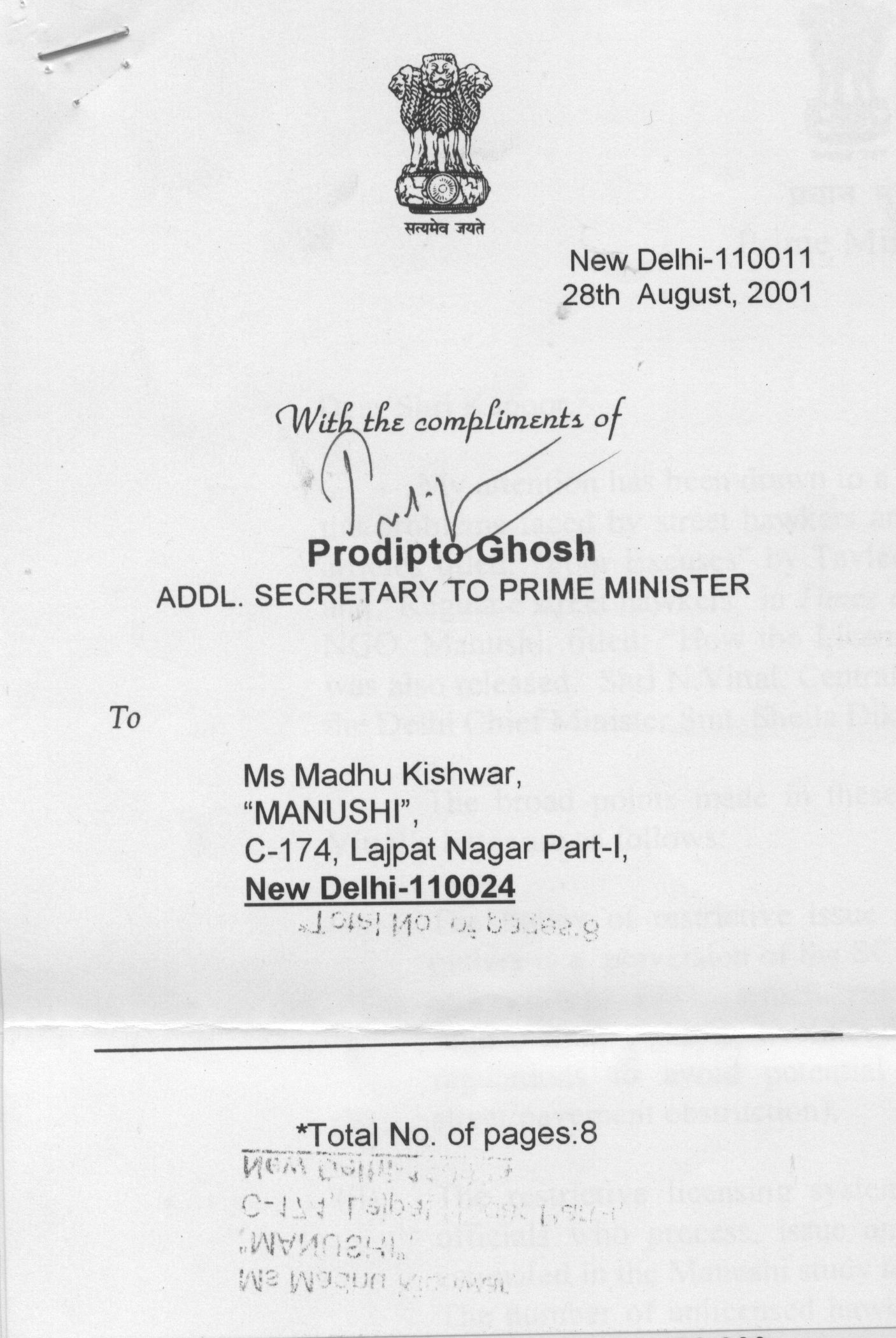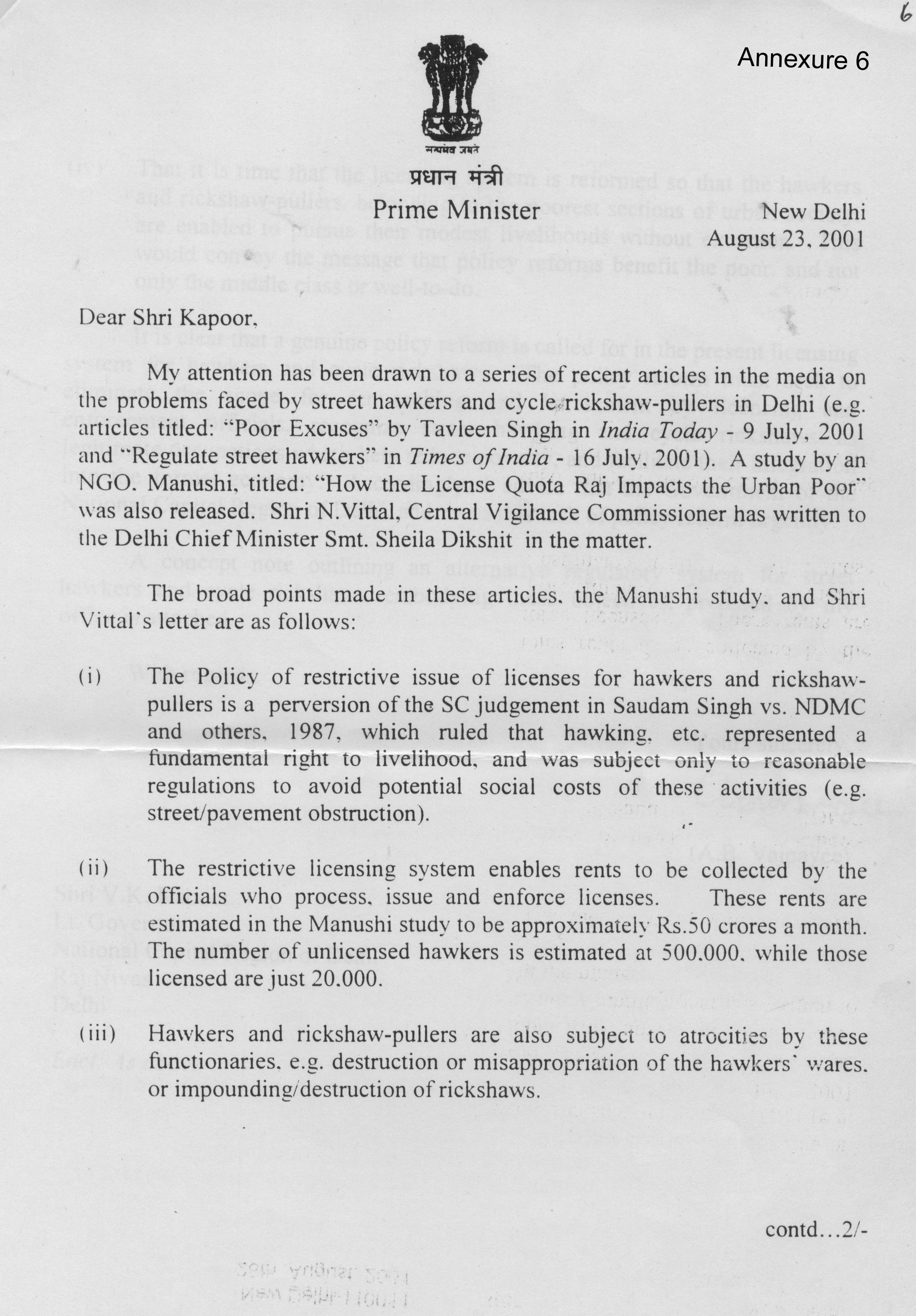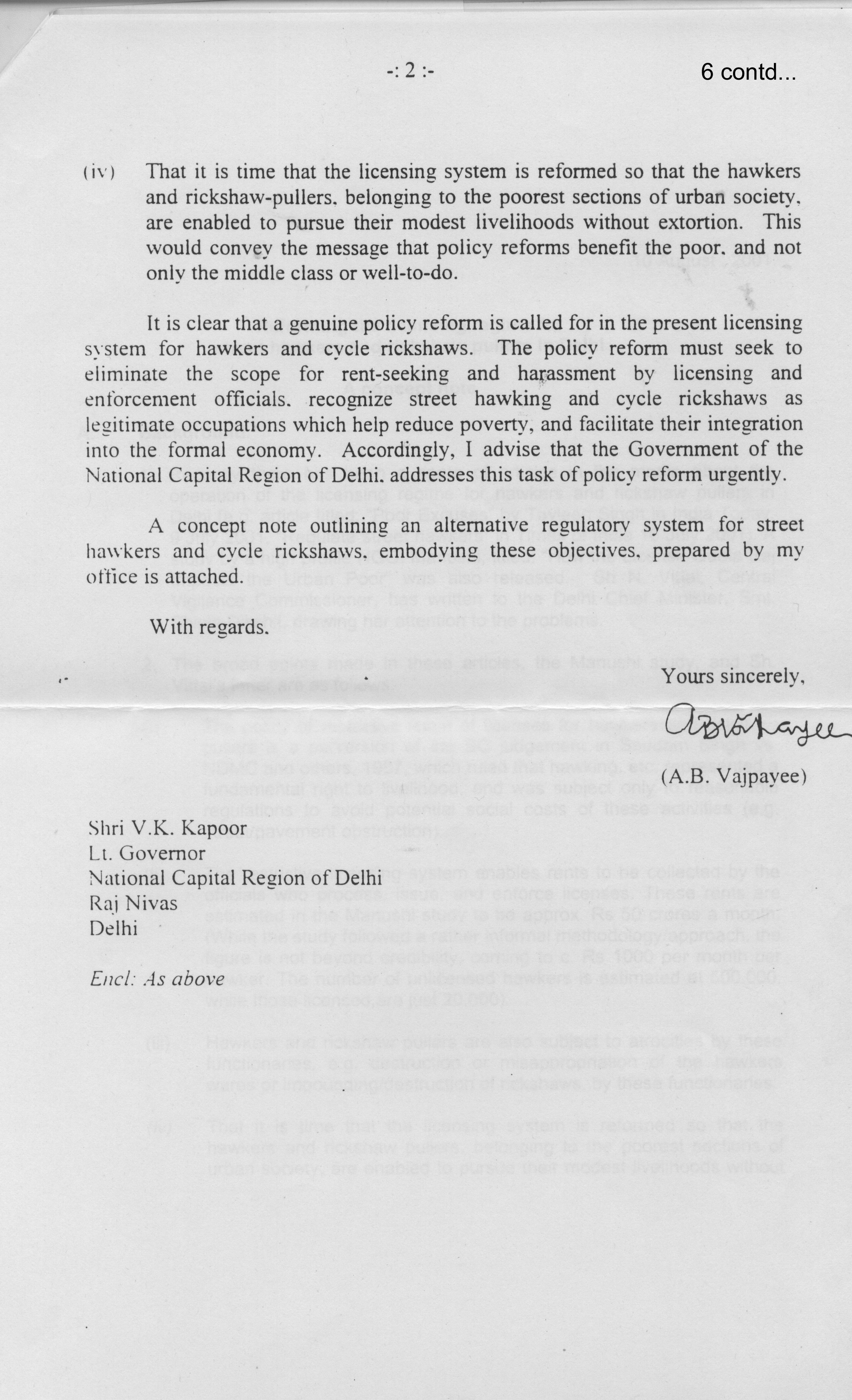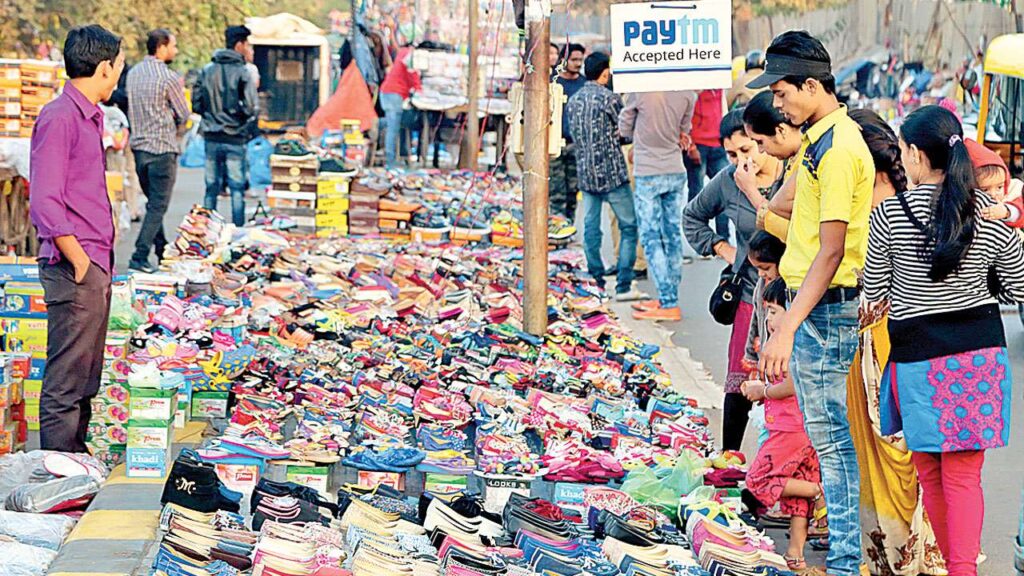


A. Background:
1. Recently there has been a spate of articles in the media about the operation of the licensing regime for hawkers and rickshaw pullers in Delhi (e.g. article titled: "Poor Excuses" by Tavleen Singh in India Today, 9 July 2001, "Regulate street hawkers" in Times of India 16 July 2001). A study by a high profile NGO, Manushi, titled: "How the License Quota Raj Impacts the Urban Poor" was also released. Sh N. Vittal, Central Vigilance Commissioner, has written to the Delhi Chief Minister, Smt. Sheila Dikshit, drawing her attention to the problems.
2. The broad points made in these articles, the Manushi study, and Sh. Vittal's letter are as follows:
- The policy of restrictive issue of licenses for hawkers and rickshaw pullers is a perversion of the SC judgement in Saudam Singh vs. NDMC and others, 1987, which ruled that hawking, etc. represented a fundamental right to livelihood, and was subject only to reasonable regulations to avoid potential social costs of these activities (e.g. street/pavement obstruction).
- The restrictive licensing system enables rents to be collected by the officials who process, issue, and enforce licenses. These rents are estimated in the Manushi study to be approx. Rs 50 crores a month. (While the study followed a rather informal methodology/approach, the figure is not beyond credibility, coming to c. Rs 1000 per month per hawker. The number of unlicensed hawkers is estimated at 500,000, while those licensed are just 20,000).
- Hawkers and rickshaw pullers are also subject to atrocities by these functionaries, e.g. destruction or misappropriation of the hawkers' wares or impounding/destruction of rickshaws, by these functionaries.
- That it is time that the licensing system is reformed so that the hawkers and rickshaw pullers, belonging to the poorest sections of urban society, are enabled to pursue their modest livelihoods without extortion. This would convey the message that policy reforms benefit the poor, and not only the middle class or well-to-do.
B. Origin of the licensing system:
3. The licensing system for hawkers was given legitimacy in a Supreme Court decision in Saudam Singh and others vs NDMC, SLP © No. 15257/87. In this judgement, the SC while ruling that the fundamental right of livelihood under Art. 19(1)(g) of the Constitution cannot be denied to street/pavement hawkers, held that this right was subject to regulation by way of reasonable restrictions under Art. 19 (6) of the Constitution, by the State (as trustee of the public in relation to streets). Specifically, in relation to street hawkers, the SC observed:" So far as the right of a hawker to transact business while going from place to place is concerned, it has been admittedly recognized for a long period. Of course, that also is subject to proper regulation in the interest of general convenience of the public including health and security considerations". While no specific SC ruling is available for rickshaws, they may be interpreted as street hawkers providing a transportation service, (rather than a tangible commodity), and accordingly covered by the SC Saudam Singh vs NDMC decision (relating to the fundamental right to livelihood subject only to minimal regulation). MCD licenses for (commodity) street hawkers are issued under Section 420 of the MCD Act, and for cycle rickshaws under Section 489 of the MCD Act. There are analogous provisions in the NDMC regulations.
4. The licensing system for both street hawkers and cycle rickshaws seek to limit the numbers of these tradespersons. Further, they impose a number of restrictive conditions which do not seem to relate to "general convenience of the public including health and security considerations" or give wide discretion to officials, which is potentially open to misuse.
C. Effects of the licensing system:
5. Hawking and cycle rickshaws provide low cost, easily accessible retail and transportation services to urban households. Because of the low cost, most of the users are low-income households. They are also highly labour-intensive, and because of their small scale of operations, involve low capital entry requirements. Accordingly, they are among the easiest occupations to enter for the urban poor. By providing employment and low-cost services, they enhance societal welfare and accordingly should be encouraged as a matter of public policy. Further, it has been pointed out1 that hawkers provide other indirect societal benefits, i.e. their presence reduces the scope for eve-teasing, and by reducing transportation requirements for shopping, to reduced pollution.
6. On the other hand, concerns have been expressed about the possible social costs of these occupations. These are centred on street congestion, hygiene, and security (petty crime). These are discussed below:
7. Street congestion: A simple economic analysis of markets for these services shows that the numbers of providers is inherently limited by market demand. If the number of providers (supply of the goods or service) is limited by fiat (as in a quantity based licensing system), two things will happen: first, the price of the services will rise to above the (marginal) cost of supply giving rise to a potential rent, and second, that officials who issue licenses will be well-placed to collect (most of) this rent, so long as the slightest element of discretion is involved in the selection of licensees. Further, because of rise in the price of the services, non-licensed providers would seek to enter the market. This provides an opportunity for the enforcers to collect rents. The result is that consumers pay higher prices, the number of service providers (and hence employment) is reduced, and officials who dispense and enforce licenses collect rents. This is exactly the situation which prevailed in the regime of industrial licensing.
8. In any large, heterogeneous city, the market demand for hawking (and cycle rickshaw) services varies by locality, time of day, day of the week, and in each of these, over time. Depending on the density of streets and built-up areas, without licensing or other regulation, street congestion may not occur in particular areas at all, in some areas almost all the time, and in others, at particular times (of day, day of the week, etc). Accordingly, the problem of street congestion by hawkers and cycle rickshaws can be disaggregated into "green" (no restriction), "red" (prohibited), and "amber" (regulated) areas. In respect of regulation, as noted above, quantity-based regulations (licenses) furnish scope for rent-seeking. The alternative of fee-based regulation for "amber" areas, (i.e. no restriction on entry so long as one pays an entry fee to the municipality), if properly designed, may eliminate the scope for rent-seeking.
9. Hygiene: Hygiene is implicated in relation to street hawkers in two aspects. One, in relation to foodstuffs peddled by them. Second, on the (external) pollution caused by their garbage. On neither count is the concern categorically different from that due to other service providers, e.g. restaurants. However, the mobile nature of the hawkers may mean that regulatory measures (in particular for food adulteration) may be difficult to enforce. The problem then reduces to means of identification of particular vendors.
10. Security, law and order: The concern is that street hawking (and cycle rickshaws) may sometimes be a cover for illicit activities, e.g. peddling narcotics, pimping, etc. Once again, the concern is not categorically different from that due to other service providers. Similar to the issue of hygiene, the problem reduces to means of ensuring identification of street hawkers (and cycle rickshaw pullers).
D. Other issues:
11. If one considers that street hawking and cycle rickshaws are legitimate occupations providing positive net societal benefits, one should also seek to put in place mechanisms to facilitate technological upgrading of the activities, and access to the institutions of the formal economy. These are discussed below:
12. Technology upgrading: Technology upgrading would help ensure increased labour productivity in these activities. They may also help reduce hygiene and pollution impacts, or street congestion (by increasing mobility). However, technology upgrading requires investment, and investment requires an absence (or reduction) of risk. Clearly, so long as a licensing system which enables the licensor/enforcer to extract the entire rents of the activities persists, savings (and investment) by the service providers will not happen. On the other hand, if the policy environment is conducive to investment, suppliers of improved technologies will enter the market.
13. Formal Economy Institutions: Such institutions would comprise institutional finance (including micro-finance), franchised retail marketing, etc. However, access to such institutions, which is also conducive to technological up-gradation, is risky so long as the majority of hawkers/cycle rickshaws are "unlicensed", and therefore have no legal standing (in fact are "illegal"), and subject to removal. Formal economy institutions would also perceive less risk if the clients (hawkers and rickshaw pullers) were properly identified.
E. An Alternative Regulatory System:
14. Based on the foregoing analysis, an alternative regulatory regime for street hawkers and cycle rickshaws is outlined as follows:
- The existing licensing system with quantitative limits must be scrapped forthwith.
- The metropolis may be divided into "green", "amber", and "red" zones, signifying free access, fee-based access, and prohibited access, respectively. The division into "green", "amber", and "red" categories may vary with time of day, day of the week, and day of the month, and maybe revised periodically. The division may be made separately for street hawkers and cycle rickshaws. Such zoning must be both formally notified, and prominent street signs put up to indicate their boundaries and timings. The division may be made by the MCD/NDMC in their jurisdictions, but invariably with the formal consultation of residents' associations and the area elected representatives. Other general (i.e. applicable to all) restrictions on street hawking/cycle rickshaws may be specified in minimal terms and strictly consistent with the Saudam Singh vs NDMC judgement, i.e. in the interest of general convenience of the public including health and security considerations, e.g. avoidance between midnight and 5 am, no overnight squatting/parking on the pavements, no stopping on the carriageway, all garbage to be removed and properly disposed off, no obstructions at traffic lights or bus stops. (Restrictions on adulterated food, narcotics, etc. must flow from the respective legislations, not as further restrictions specific to these occupations). Conversely, there must be an absolute prohibition on municipal and police authorities from impounding, or destruction, or seizure, of goods and equipment, except when permitted under other laws (e.g. excise laws).
- Any person who wishes to be a street hawker or cycle rickshaw puller may do so by a simple act of registration involving two steps: (a) reliable identification by any means (e.g. voters id, ration card, passport, driving license, a letter from an elected representative or citizen in good standing), and (b) payment of a nominal fee to cover costs of issue ot a photo identification card. Upon registration, which should be done on the spot, the person would have unrestricted access to all "green" areas. Penalties for non-registration must be restricted to a surcharge on the fee, but impounding, destruction, or seizure of the goods and equipment by any authority must be absolutely prohibited. The registrations may be renewed (say, once a year) by payment of a modest renewal fee, and affixing the current period's sticker on the registration id. The sole purpose of the registration is to provide reliable identification for the purposes noted above. It is not a permit to ply the trade. No such permit is needed, being a fundamental right (as established in Saudam Singh & ors vs. NDMC). Accordingly, there must be no numerical limits on registrations.
- A registered street hawker/cycle rickshaw puller who wishes to ply in an "amber" zone, may do so by paying a fee, upon which a sticker to the effect may be affixed on the registration id. Once again, there must not be any quantity or numerical restrictions on the issue of such stickers. Numbers of street hawkers/cycle rickshaws in the "amber" zones may instead be regulated by adjustment of the amount of fee periodically (this fee need not be nominal, but may serve to limit numbers to a level at which significant congestion does not occur). Once again, penalties for plying in an "amber" zone without payment of a fee may involve a financial penalty, in addition to the fee, but in any case, there must be an absolute prohibition on municipal and police authorities from impounding, or destruction, or seizure, of goods and equipment. The fee may be scaled to different categories of street hawkers, e.g. peddlers on foot; or using pedalled vehicles; or using animal-drawn vehicles; or using motorized vehicles of below 800 cc engine capacity; or using motorized vehicles of above 800 cc; etc.
- Non-government organizations with a record of working for the welfare of street hawkers and rickshaw pullers may be authorized to interface between them and the concerned MCD/NDMC authorities in respect of registration and renewals, issuance of "amber zone" stickers, and enforcement measures. Such interfacing by NGOs may provide employment to unemployed urban youth.

